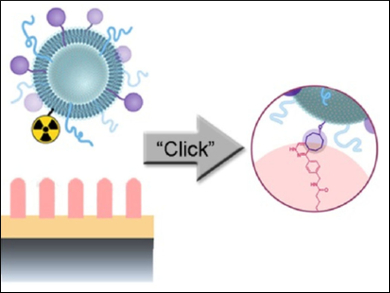Radio-labeled liposomal pharmaceuticals are used for various diagnostic and therapeutic applications. Radiopharmaceuticals can passively accumulate within tumors by using the enhanced permeability and retention (EPR) effect. With increased accumulation, positron emission tomography (PET) can be used to delineate the tumor. Unfortunately, however, circulating liposomal nanoparticles tagged with long-lived radionucleotides, such as 89Zr and 64Cu, can deliver a large dose of radiation to non-targeted organs.
Thomas Reiner, Memorial Sloan Kettering Cancer Center, New York, USA, and colleagues have developed a method for the specific binding of liposomal radiopharmaceuticals to a CoCrMo alloy through an irreversible inverse electron-demand Diels–Alder (IEDDA) reaction. The team synthesized 89Zr-radiolabeled trans-cyclooctene (TCO)-functionalized liposomes. They then used a tetrazine-functionalized polydopamine-coated CoCrMo (Tz-PDA@CoCrMo) stent alloy to selectively remove them from the blood pool of tumor-bearing mice.
The specific binding between the two counterparts (pictured) through a rapid bioorthogonal IEDDA click reaction is a step towards a new technology for the on-demand removal of circulating liposomal nanoparticles in vivo. This could result in a systemic decrease in the radiotherapeutic dose deposited in healthy tissues and yield a larger therapeutic window, better treatment outcomes, and ultimately better prognoses.
- Specific Binding of Liposomal Nanoparticles through Inverse Electron-Demand Diels-Alder Click Chemistry,
Christian Brand, Pasquale Iacono, Carlos Pérez-Medina, Willem J. M. Mulder, Moritz F. Kircher, Thomas Reiner,
ChemistryOpen 2017.
DOI: 10.1002/open.201700105




